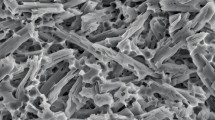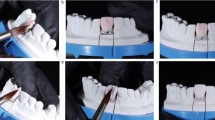Abstract
This is the first part of a six-part series exploring the main ceramic materials used for the fabrication of all-ceramic, indirect restorations to aid clinicians in their selection. We have detailed the history of how dental ceramics were introduced and how they have been revolutionised with the help of improvements within technology and understanding of the material. Dental ceramics can be classified in a few ways. One way is according to their ratio of glass to crystalline content and the other is how it is processed. Having a good in-depth understanding of this will allow clinicians to make the best decision for their patients who require ceramic restorations. This article aims to explore all the above to aid clinicians in making that decision.
Key points
-
Highlights the various ceramic classification systems.
-
Explains the various ceramic processing techniques.
-
Compares the differences between the different processing techniques.
This is a preview of subscription content, access via your institution
Access options
Subscribe to this journal
Receive 24 print issues and online access
$259.00 per year
only $10.79 per issue
Buy this article
- Purchase on Springer Link
- Instant access to full article PDF
Prices may be subject to local taxes which are calculated during checkout




Similar content being viewed by others
References
Kelly J R, Benetti P. Ceramic materials in dentistry: historical evolution and current practice. Aust Dent J 2011; DOI: 10.1111/j.1834-7819.2010.01299.x.
Babu P J, Alla R K, Alluri V R, Datla S R, Konakanchi A. Dental Ceramics: Part I - An Overview of Composition, Structure and Properties. Am J Mat Eng Technol 2015; 3: 13-18.
Helvey G. Ceramics. Compend Contin Educ Dent 2010; 31: 309-311.
Zhang Y, Kelly J R. Dental Ceramics for Restoration and Metal Veneering. Dent Clin North Am 2017; 61: 797-819.
Anusavice K J, Shen C, Rawls H R. Phillips' science of dental materials (12th ed). Philadelphia: Saunders, 2013.
Gracis S, Thompson V P, Ferencz J L, Silva N R F A, Bonfante E A. A new classification system for all-ceramic and ceramic-like restorative materials. Int J Prosthodont 2015; 28: 227-235.
McLaren E A, Cao P T. Ceramics in Dentistry - Part I: Classes of Materials. Inside Dent 2009. Available at https://www.aegisdentalnetwork.com/id/2009/10/many-different-types-of-ceramic-systems-have-been-introduced-in-recent-years-for-all-types-of-indirect-restorations (accessed December 2021).
Shenoy A, Shenoy N. Dental ceramics: An update. J Conserv Dent 2010; 13: 195-203.
Adair P J. Glass-ceramic dental products. United States Patent Application US4431420A. US: United States Patent & Trademark Office, 1984.
Datla S R, Alla R K, Alluri V R, P J B, Konakanchi A. Dental Ceramics: Part II - Recent Advances in Dental Ceramics. Am J Mat Eng Technol 2015; 3: 19-26.
Giordano R, McLaren E A. Ceramics overview: classification by microstructure and processing methods. Compend Contin Educ Dent 2010; 31: 682-684.
International Organisation for Standardisation. ISO 6872:2015 Dentistry - Ceramic materials. 2015. Available at https://www.iso.org/standard/59936.html (accessed December 2021).
Helvey G A. Classifying dental ceramics: numerous materials and formulations available for indirect restorations. Compend Contin Educ Dent 2014; 35: 38-43.
Rezaie H R, Rizi H B, Khamseh M M R, Öchsner A. A Review on Dental Materials. Switzerland: Springer Nature, 2020.
Brown C. Options in Dental Milling. Inside Dent Technol 2013. Available at https://www.aegisdentalnetwork.com/idt/2013/06/options-in-dental-milling (accessed Decmber 2021).
Pyo S-W, Kim D-J, Han J-S, Yeo I-S L. Ceramic Materials and Technologies Applied to Digital Works in Implant-Supported Restorative Dentistry. Materials (Basel) 2020; DOI: 10.3390/ma13081964.
DGSHAPE. Wet and dry milling solutions. How they work and what they offer. 2018. Available at https://www.rolanddg.eu/-/media/roland-emea/dgb/brochure/wet-and-dry-milling-solutions_how_they_work.pdf?la=en&hash=FC1749B3F120EE580A47F6BEF5C682231996B37 (accessed December 2021).
Santander S A, Pelaez-Vargas A, Escobar J S, Monteiro F J, Tamayo L F R. Ceramics for Dental Restorations - An Introduction. Dyna (Columbia) 2010; 77: 26-36.
Fasbinder D J, Dennison J B, Heys D, Neiva G. A clinical evaluation of chairside lithium disilicate CAD/CAM crowns: a two-year report. J Am Dent Assoc 2010; DOI: 10.14219/jada.archive.2010.0355.
Palin W, Burke F J. Trends in indirect dentistry: 8. CAD/CAM technology. Dent Update 2005; 32: 566-572.
Ding H, Tsoi J K-H, Kan C-W, Matinlinna J P. A simple solution to recycle and reuse dental CAD/CAM zirconia block from its waste residuals. J Prosthodont Res 2021; 65: 311-320.
Tsoi J K-h, Ding H, Matinlinna J. Recycling Dental Zirconia Wastes: Is It Feasible? International Association for Dental Research 2017. Available at https://iadr.abstractarchives.com/abstract/ced-iadr2017-2756110/recycling-dental-zirconia-wastes-is-it-feasible (accessed December 2021).
Gorman C M, Horgan K, Dollard R P, Stanton K T. Effects of repeated processing on the strength and microstructure of a heat-pressed dental ceramic. J Prosthet Dent 2014; 112: 1370-1376.
Acknowledgements
Fine Art Studio Dental Lab, Birmingham produced the ceramic work in all images and we thank them for all of their support.
Author information
Authors and Affiliations
Contributions
Mojgan Talibi: co-author, conceptualisation, drafting and editing of the manuscript to create the final version, photographing images and producing figures. Kiran Kaur: co-author, conceptualisation, drafting and editing of the manuscript to create the final version and referencing. Hiten Parmar and Hussein Patanwala: supervisors and reviewing the manuscript. Mojgan Talibi and Kiran Kaur contributed equally towards this manuscript.
Corresponding author
Ethics declarations
The authors declare no conflicts of interest.
Rights and permissions
About this article
Cite this article
Talibi, M., Kaur, K., Patanwala, H. et al. Do you know your ceramics? Part 1: classification. Br Dent J 232, 27–32 (2022). https://doi.org/10.1038/s41415-021-3818-x
Received:
Accepted:
Published:
Issue Date:
DOI: https://doi.org/10.1038/s41415-021-3818-x
This article is cited by
-
Ceramics overview
British Dental Journal (2022)



